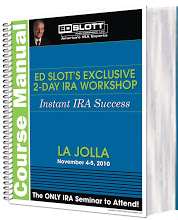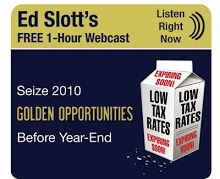Monday, December 22, 2008
Tis The Season: Make a List and Check It Twice
You can give plenty of presents to your clients this holiday season by making a list and checking it twice, being careful not to miss some important year-end deadlines while managing your clients’ money. Before 2008 turns into a New Year, you must follow this checklist to make sure you are serving your clients’ best interest during the busy weeks ahead.
1) Have all required distributions for the year been satisfied? There is a 50% (that is NOT a misprint) penalty on the amount not taken.
· Account Owner RMDs
Anyone attaining the age of 70 ½ in 2008 or a prior year has an RMD from their IRA, SEP and SIMPLE IRA accounts, whether or not they are still working. If they are still working, they may not have to take a distribution from the company plan of the company they are still working for as long as they own less than 5% of the company. The first year’s distribution (the year age 70 ½ is reached) can be deferred until April 1 of next year.
· Beneficiary RMDs
Anyone who has inherited a retirement account (where they were named on the beneficiary form), has a required distribution beginning in the year after the death of the account owner. A spouse beneficiary does not have a required distribution until the year the decedent would have been 70 ½.
· Beneficiary RMDs from Roth IRAs
There are required distributions to Roth IRA beneficiaries beginning in the year after the Roth IRA owner’s death.
· Year of Death RMDs
Death gets you out of almost everything, but not out of a required distribution. The required distribution is calculated as though the account owner lived for the entire year. It is payable to the beneficiary, not to the decedent, not to the estate (unless the estate is the named beneficiary), but to the beneficiary.
· Early Distribution Payments
This one is not subject to the 50% penalty. For a client taking early distributions under a 72(t) plan (or substantially equal payment plan - SEPP, or series of substantially equal payments - SOSEP), make sure that the total amount for the year has been distributed. If too little, or too much, is distributed for the year, the client will be subject to the recapture penalty of 10% assessed on all distributions made prior to age 59 ½.
2) Roth IRA conversions for the current year - funds must leave the traditional IRA before year end
3) Lump sum distributions from company plans must be completed in order to qualify for 10 year averaging and NUA treatment
4) Check to see that all employer stock qualifying for NUA treatment has been transferred to a non-tax deferred account
5) Inherited accounts must be split by 12/31 of the year after the account owner’s death in order for individual beneficiaries to be able to use their own life expectancies when calculating required distributions
*2009 Copyright Ed Slott and Company, LLC
Wednesday, December 3, 2008
Beware the Free Look
When you purchase or invest in an annuity, there is a free look period. During that period you can change your mind and get your funds back with no penalties involved.
Or are there?
If you are using after-tax money to fund the annuity and you decide during the free look period to cancel the deal, there are generally no penalties. The outcome can be very different if you are using IRA funds. Many IRA owners tend to think of their IRAs in the same terms as a savings account. You put money in and when you need funds you take it out. You open an IRA at Bank A and when Bank B has a higher rate, you move the funds to Bank B. But IRAs have very specific rules on how money can be taken out of the account and how it can be moved to another account.
Rollovers: A rollover is when the IRA owner can spend the funds while they are outside of the IRA, for example when a check is issued payable to the IRA owner or the owner takes a cash distribution from the account. You are only allowed to take one rollover distribution per IRA account per year (12 months). An account can receive multiple rollovers, but once it has received a rollover it cannot do a rollover distribution for one year. In addition, when you take a rollover distribution, you only have 60 days from the date the funds are received to put those funds into another IRA account.
Trustee-to-Trustee Transfer (Direct Transfer): A transfer is when the funds are moved directly from one IRA custodian to another. The account owner does not have the ability to spend the funds while they are out of the IRA. A check sent to the IRA owner that is payable to the new IRA custodian is considered a transfer, not a rollover. The IRA owner can do an unlimited number of transfers each year.
We always recommend that IRA funds be moved as a transfer. Then you never have to worry about the one rollover per year rule. However, due to the current economy and the situation in the financial markets many IRA owners are very concerned about where their funds are right now. They are making impulsive decisions to move their money and they are taking rollover distributions.
When the IRA owner takes the funds he has received as a rollover and places them in an IRA annuity within 60 days, he is safe. But if he subsequently decides during the free look period that he does not want the annuity and he cancels the transaction, he generally receives a check payable to himself. Another rollover. Now the IRA owner has a problem because he can only do one rollover every 12 months with those funds. So his free look period and his ability to cancel the IRA annuity work out just fine, but he is left with the ultimate penalty, full taxation on the IRA balance. He no longer has an IRA.
Whenever possible, move IRA funds as a trustee-to-trustee or direct transfer and avoid doing a rollover. Don’t let the search for a safe investment for your IRA funds end up in a loss of the tax deferred status of the IRA account.
*Copyright 2009 Ed Slott and Company, LLC
Monday, December 1, 2008
Difficult Decisions with SOSEPP
Early retirees - those individuals who are in what we will call an age limbo, between 59 ½ years of age and 62- are getting hit the hardest. These individuals haven’t hit the magic age of 62 necessary to collect Social Security. It is even more damaging if they are under age 59 ½ and are forced to draw down their IRAs, which means they are relying on the 72(t) rules to avoid early withdrawal penalties. They must consider three unappealing options in some cases. They can cut their spending, deplete their IRAs or go back to work and push back retirement.
It’s not how they pictured celebrating their golden years.
How can a financial advisor assist with this predicament? You can stand out in a crowd by knowing section 72(t) of the tax code like the back of your hand. If your client must withdraw from his or her IRA before age 59 ½, you can make sure he or she avoids a 10% penalty by suggesting a series of substantially equal periodic payments (SOSEPP). You can find out more about the pros and cons of these payments by reading an article by Donald Jay Korn on Financial Planning’s website. CLICK HERE to read the rest of the article, which contains pertinent information along with Ed Slott's and other IRA professionals' insight and recommendations.















